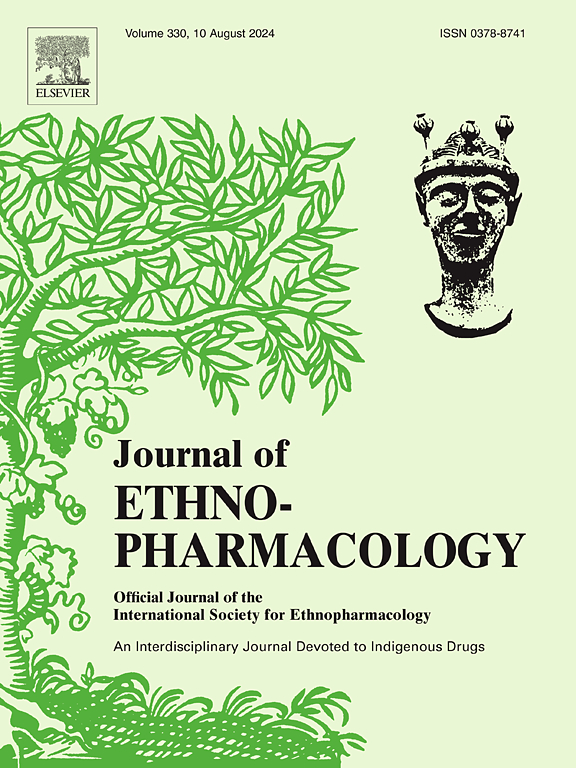Epimedii Folium and Ligustri Lucidi Fructus synergistically delay renal aging through AMPK/ULK1/Bcl2L13-mediated mitophagy
IF 4.8
2区 医学
Q1 CHEMISTRY, MEDICINAL
引用次数: 0
Abstract
Ethnopharmacological relevance
The root of aging is attributed to kidney essence insufficiency and gradual loss of kidney function. The combination of Epimedii Folium and Ligustri Lucidi Fructus (ELL) is traditionally recognized to tonify kidney yin and yang and has significant efficacy in delaying aging and aging-related diseases, but little is known about the exact mechanism.
Aim of the study
The research focuses on the mechanism of delaying renal aging by which ELL regulates mitophagy through serine/threonine kinase AMP-activated protein kinase (AMPK)/UNC-51- like autophagy activating kinase 1 (ULK1)/B-cell lymphoma-2-like protein 13 (Bcl2L13) in vivo.
Materials and methods
We employed a rat model of natural aging, using rats of different ages as dynamic controls, and a natural aging mouse model to evaluate the effects of ELL on delaying renal aging via AMPK/ULK1/Bcl2L13. The assessment included renal histopathology, oxidative stress, cell senescence, mitochondrial dynamics, mitophagy, and the AMPK/ULK1/Bcl2L13 signaling pathway. In the aging rat model, network pharmacology and proteomics were combined to dissect the renal aging process, and a Multilayer Perceptron (MLP) -artificial neural networks (ANN) model was used to evaluate the effects of ELL comprehensively. In the aging mouse model, the AMPK inhibitor dorsomorphin was applied to assess whether the AMPK signaling pathway was involved in ELL-induced mitophagy.
Results
Compared with the young rats, the kidney exhibited signs of degenerative pathologies and increased oxidative stress in 17-month-old rats. A thorough analysis identified the mitochondrial protein Bcl2L13 as a crucial biomarker associated with renal aging. The AMPK/ULK1/Bcl2L13 pathway significantly regulated mitochondrial function and mitophagy, which were potential mechanisms underlying renal aging. In contrast to aged rats, the renal pathological changes and cell senescence in rats treated with ELL were significantly mitigated, the antioxidant capacity, mitochondrial dynamics, and mitophagy were improved, and the expression of AMPK/ULK1/Bcl2L13 was upregulated. After the application of AMPK inhibitor dorsomorphin, the effects of ELL were reversed. It appears that ELL modulates the AMPK/ULK1/Bcl2L13 signaling pathway, and upregulates mitophagy to potentially decelerate renal aging.
Conclusions
The findings indicate that aging kidneys display mitochondrial dysfunction, disorganization of mitochondria, and a decrease in mitophagy. Concurrently, ELL significantly regulates mitochondrial dynamics and mitophagy via AMPK/ULK1/Bcl2L13. This regulation helps mitigate mitochondrial dysfunction, suggesting ELL as a promising herbal remedy for delaying renal aging and age-related kidney diseases.

求助全文
约1分钟内获得全文
求助全文
来源期刊

Journal of ethnopharmacology
医学-全科医学与补充医学
CiteScore
10.30
自引率
5.60%
发文量
967
审稿时长
77 days
期刊介绍:
The Journal of Ethnopharmacology is dedicated to the exchange of information and understandings about people''s use of plants, fungi, animals, microorganisms and minerals and their biological and pharmacological effects based on the principles established through international conventions. Early people confronted with illness and disease, discovered a wealth of useful therapeutic agents in the plant and animal kingdoms. The empirical knowledge of these medicinal substances and their toxic potential was passed on by oral tradition and sometimes recorded in herbals and other texts on materia medica. Many valuable drugs of today (e.g., atropine, ephedrine, tubocurarine, digoxin, reserpine) came into use through the study of indigenous remedies. Chemists continue to use plant-derived drugs (e.g., morphine, taxol, physostigmine, quinidine, emetine) as prototypes in their attempts to develop more effective and less toxic medicinals.
 求助内容:
求助内容: 应助结果提醒方式:
应助结果提醒方式:


